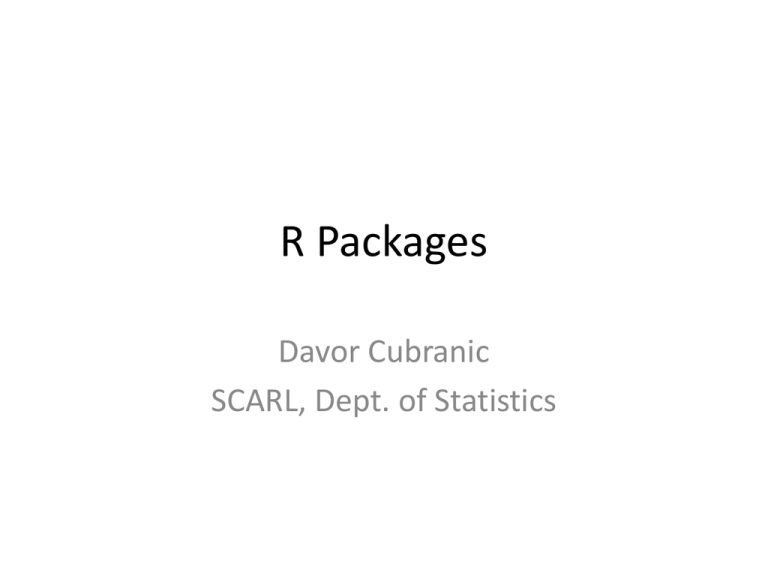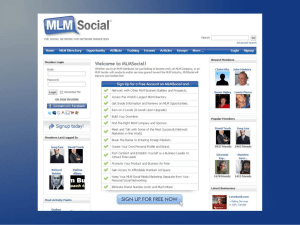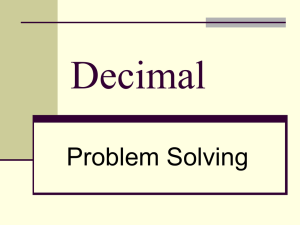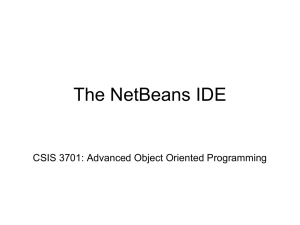Advanced R - Packages
advertisement

R Packages
Davor Cubranic
SCARL, Dept. of Statistics
Warmup questions
• Who here uses packages?
• Which ones?
• How do you know you’re using a package?
– Had to install it
– Had to load it
• What happens when you load it?
– Functions
– Data
– Help pages
• So package is a bundle of “stuff”
• But, (next slide)
• It’s a structured bundle of…
What is a package?
• Structured, standardized unit of:
– R code
– documentation
– data
– external code
Why use packages (talking points)
• Installation & administration is easy
– Finding, installing, compiling, updating…
• Validation
– Package checks
• Distribution mechanisms
– CRAN, Bioconductor, Github
• Documentation
– Bundle examples, demos, tutorials
• Organization
– Especially useful for the programmers:
– Self-contained (names)
– Declare and enforce dependencies on other packages
Why use packages
•
•
•
•
•
Installation & administration
Validation
Distribution
Documentation
Organization
• Knowing how packages work and how to use
them effectively will make you more effective R
analyst, even if you don’t develop new packages
• But you should consider developing packages
even if you don’t write the next ggplot
• Packages for your own stuff:
- Analyses you frequently repeat and/or share with
others
- Publication: create a package containing the publication
as a vignette, and bundle the code and data with it
Handling packages
• Load with library(name)
• Package-level help:
– library(help=name)
• Unload with detach(package:name)
– You shouldn’t have to do this
Handling packages with RStudio
•
•
•
•
See the packages tab in Rstudio
Checkmark to load
Some are already loaded!!
Click on the name for help
What happens when you load a
package?
• When you start R you have an empty
workspace
• But there is also all this other “basic” R stuff
(matrix, plot)
• So it’s more like we have two boxes, your
workspace and “core” R
• Actually, it’s more like a whole bunch of boxes:
see search()
So what happens when you load?
• New package gets inserted near the front of
the list
• It can pull additional packages (dependencies)
• But notice that each package is its own bundle
(box)
• We’ll talk how you create these bundles next
Structure
• What makes package a package is that it
follows a prescribed structure of files and
directories
• If you tell R to treat this as a package, it will
• You can create it by hand, but we’ll use a
shortcut: package.skeleton()
package.skeleton()
• Convenient for turning a set of existing
functions and scripts into a package
• Let’s do it with the anova.mlm code that we
wrote earlier
• New project:
– scdemoXX@vscarl1.stat.ubc.ca:~scdemo/pkg
• source(‘anova.mlm.R’)
• package.skeleton(“anovaMlm”, ls())
DESCRIPTION
• The only required part of a package
• Name, author, license, etc.
R/
• Directory for R code
• package.skeleton creates one file per function
• This is not a rule, you can put as many
functions into a single file
man/
• Help files
NAMESPACE
• Defines which objects are visible to the user
and other functions
• Public vs. private to the package
• The default is to make everything visible that
starts with a letter
Command-line tools
• Check
• Install
• Build
INSTALL
• Let’s install our package
• R CMD INSTALL anova.mlm
• Delete the “man” directory
– (it’s optional and we’ll recreate it later)
• Redo INSTALL
• Restart R studio
• library(“anova.mlm”)
check
• Really important!!!
• Finds common errors, non-standard parts
• CRAN requires no ERRORS or WARNINGS
Optional contents
•
•
•
•
•
•
•
•
man/: documentation
data/: datasets
demo/: R code for demo purposes
inst/: other files to include in the package (PDFs,
vignettes)
tests/: package test files
src/: C, C++, or Fortran source code
NEWS: history of changes to the package
LICENSE or LICENCE: package license
DESCRIPTION
• Depends:
– packages used by this one
– and loaded as part of its loading
– i.e., visible to the user
• Imports:
– packages used by this one
– but not loaded
– i.e, not visible to the user
• Suggests:
– used in examples or vignettes
– non-essential functionality
NAMESPACE
• exportPattern(“^[[:alpha:]]”)
• export(anova.mlm, est.beta)
• S3method(print, anova.mlm)
• S3method(plot, anova.mlm)
• import(MASS)
• importFrom(MASS, lda)
Documentation
• Let’s re-generate the documentation files
• promptPackage(“anova.mlm”)
• prompt(anova.mlm)
anova.mlm.Rd
• Description: Compute a (generalized) analysis
of variance table for one or more multivariate
linear models.
• Arguments:
– object: an object of class '"mlm”’
– ...: further objects of class '"mlm"’.
– force.int: Force intercept
• Value: An object of class “anova” inheriting
from class “matrix”
Help files for methods
• \usage{anova.mlm(…)}
• For S3 methods:
– \usage{\method{print}{anova.mlm}(….)}
Vignettes
• .rnw extension
• Written in Sweave
– similar to knitr
• Latex + R code
• Produces a PDF available in the installed
package
• vignette()
• vignette(‘Sweave’)
Help on writing packages
• Lots of tutorials on the Web
– many of them are not necessarily correct
– NAMESPACES, Imports, etc.
• Authoritative guide: Writing R Extensions
• R-devel mailing list











